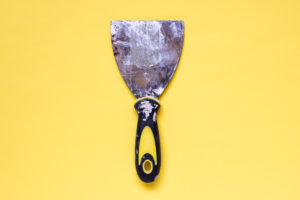Here’s How to Repair Wall Damage for a Smooth, Paintable Surface

You can’t get a great paint job without a smooth surface. That’s why prepping is so important – it gives you the chance to repair wall damage, including cracks and holes, before you roll on that first coat of paint. Here are the wall-repair tips you need to know to help you get the most out of your paint job.
Repairing Wall Damage, Big and Small
Unless you’ve patched big holes in drywall before, we recommend leaving anything bigger than the size of a hammer head to the pros. With that caveat out of the way, here are our tips for repairing wall damage, big(gish) and small.
Dents and Dings
Damage like small holes and divots is the easiest to repair. You’ll need:
- Fast-drying spackling
- Sandpaper or drywall sanding sponge
- Drywall knife
Clear away any debris from the imperfection. Smooth on fast-drying spackling with your putty knife. Wait 24 hours and then sand*.
Popped Nail Heads
Have you noticed circular bulges (or even visible nail heads) in your drywall? Those are nail pops, and they happen when drywall shifts and works a nail loose. These are purely cosmetic and simple to repair. You’ll need:
- Hammer
- Screwdriver or drill
- Wall screws (sized to penetrate the stud by at least three quarters of an inch to insure they don’t come out)
- Joint compound
- Drywall knife
- Sandpaper or drywall sanding sponge
Screw one screw into the stud about an inch above the nail and one about an inch below. Then, you can either hammer the nail back in or remove it. Wall screws are made to sink below the wall level, so you can cover them with joint compound (do the same for nail or nail hole). Wait 24 hours and sand*. If you can still see the wall damage, reapply the compound, wait 24 hours and sand* again.
Small Holes
Small holes (up to two inches) can be repaired with a patch kit. You’ll need:
- Mesh patch kit
- Drywall knife
- Spackling compound or joint compound
- Sandpaper or drywall sanding sponge
Follow the instructions on the kit for sticking the mesh patch over the hole. Use the drywall knife to apply the compound smoothly. Wait 24 hours and sand*.
Repaint
Once the wall is prepped, you’re ready to paint. If you’re repainting the whole room, note that high-gloss paints and certain textures and faux finishes can emphasize wall damage. So, when choosing your wall finish, steer toward matte, eggshell or satin for the smoothest finish.
If you want to paint high-gloss paint over a repaired wall (or add texture), prime the wall first. This will help conceal any wall repairs and will help the wall finish stick better and cover more smoothly.
Our paint pros always wall prep before they paint. Learn about our interior painting services or get free 8″ x 8″ paint swatches from our color consultants today.
*WARNING! If you scrape, sand or remove old paint, you may release lead dust. LEAD IS TOXIC. Contact the National Lead Information Hotline at 1-800-424-LEAD, or log on to www.epa.gov/lead
